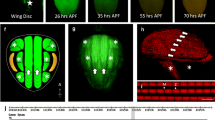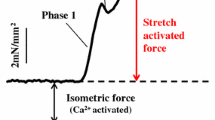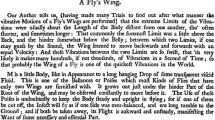Abstract
In Drosophila melanogaster two high molecular weight tropomyosin isoforms, historically named heavy troponins (TnH-33 and TnH-34), are encoded by the Tm1 tropomyosin gene. They are specifically expressed in the indirect flight muscles (IFM). Their N-termini are conventional and complete tropomyosin sequences, but their C-termini consist of different IFM-specific domains that are rich in proline, alanine, glycine and glutamate. The evidence indicates that in Diptera these IFM-specific isoforms are conserved and are not troponins, but heavy tropomyosins (TmH). We report here that they are post-translationally modified by several phosphorylations in their C-termini in mature flies, but not in recently emerged flies that are incapable of flight. From stoichiometric measurements of thin filament proteins and interactions of the TmH isoforms with the standard Drosophila IFM tropomyosin isoform (protein 129), we propose that the TmH N-termini are integrated into the thin filament structural unit as tropomyosin dimers. The phosphorylated C-termini remain unlocated and may be important in IFM stretch-activation. Comparison of the Tm1 and Tm2 gene sequences shows a complete conservation of gene organisation in other Drosophilidae, such as Drosophila pseudoobscura, while in Anopheles gambiae only one exon encodes a single C-terminal domain, though overall gene organization is maintained. Interestingly, in Apis mellifera (hymenopteran), while most of the Tm1 and Tm2 gene features are conserved, the gene lacks any C-terminal exons. Instead these sequences are found at the 3’ end of the troponin I gene. In this insect order, as in Lethocerus (hemipteran), the original designation of troponin H (TnH) should be retained. We discuss whether the insertion of the IFM-specific pro-ala-gly-glu-rich domain into the tropomyosin or troponin I genes in different insect orders may be related to proposals that the IFM stretch activation mechanism has evolved independently several times in higher insects.
Similar content being viewed by others
References
Ayme-Southgate A, Southgate R, Saide J, Benian GM, Pardue ML, (1995). Both synchronous and asynchronous muscle isoforms of projectin (the Drosophila bent locus product) contain functional kinase domains J Cell Biol 128: 393–403
Barbas JA, Galceran J, Krah-Jentgens I, de la Pompa JL, Canal I, Pongs O, Ferrus A, (1991). Troponin I is encoded in the haplolethal region of the Shaker gene complex of Drosophila Genes Dev 5: 132–140
Bautch VL, Storti RV, Mischke D, Pardue ML, (1982). Organization and expression of Drosophila tropomyosin genes J Mol Biol 162: 231–250
Boyle WJ, Geer P, Hunter T, (1991). Phosphopeptide mapping and phosphoamino acid analysis by two-dimensional separation on thin-layer cellulose plates Meth. Enzymol. 201: 110–149
Bullard B, Leonard K, Larkins A, Butcher G, Karlik C, Fyrberg E, (1988). Troponin of asynchronous flight muscle J Mol Biol 204: 621–637
Clayton JD, Cripps RM, Sparrow JC, Bullard B, (1998). Interaction of troponin-H and glutathione S-transferase-2 in the indirect flight muscles of Drosophila melanogaster J Muscle Res Cell Motil 19: 117–127
Combet C, Blanchet C, Geourjon C, Deleage G, (2000). NPS@: network protein sequence analysis Trends Biochem Sci 25: 147–150
Craig R, Lehman W, (2001). Crossbridge and tropomyosin positions observed in native, interacting thick and thin filaments J Mol Biol 311: 1027–1036
Creighton TE, Chothia C, (1989). Protein structure. Selecting buried residues Nature 339: 14–15
Cripps RM, Sparrow JC, (1992). Polymorphism in a Drosophila indirect flight muscle-specific tropomyosin isozyme does not affect flight ability Biochem Genet 30: 159–168
Domingo A, Gonzalez-Jurado J, Maroto M, Diaz C, Vinos J, Carrasco C, Cervera M, Marco R, (1998). Troponin-T is a calcium-binding protein in insect muscle: in vivo phosphorylation, muscle-specific isoforms and developmental profile in Drosophila melanogaster J Muscle Res. Cell. Motil. 19: 393–403
Dudley R, (2000). The evolutionary physiology of animal flight: paleobiological and present perspectives Annu Rev Physiol 62: 135–155
Filatov VL, Katrukha AG, Bulargina TV, Gusev NB, (1999). Troponin: structure, properties, and mechanism of functioning Biochemistry (Mosc) 64: 969–985
Fyrberg E, Fyrberg CC, Beall C, Saville DL, (1990) Drosophila melanogaster troponin-T mutations engender three distinct syndromes of myofibrillar abnormalities J Mol Biol 216: 657–675
Geeves MA, Holmes KC, (1999) Structural mechanism of muscle contraction Annu Rev Biochem 68: 687–728
Gordon AM, Homsher E, Regnier M, (2000). Regulation of contraction in striated muscle Physiol Rev 80: 853–924
Gremke L, Lord PC, Sabacan L, Lin SC, Wohlwill A, Storti RV, (1993). Coordinate regulation of Drosophila tropomyosin gene expression is controlled by multiple muscle-type-specific positive and negative enhancer elements Dev Biol 159: 513–527
Hanke PD, Storti RV, (1988). The Drosophila melanogaster tropomyosin II gene produces multiple proteins by use of alternative tissue-specific promoters and alternative splicing Mol Cell Biol 8: 3591–3602
Henkin JA, Maughan DW, Vigoreaux JO, (2004). Mutations that affect flightin expression in Drosophila alter the viscoelastic properties of flight muscle fibers Am J Physiol Cell Physiol 286: C65–C72
Herranz R, Mateos J, Marco R, (2005a). Diversification and independent evolution of troponin C genes in insects J Mol Evol 60: 31–44
Herranz R, Mateos J, Mas JA, García-Zaragoza E, Cervera M., Marco R, (2005b). The Co-Evolution of Insect Muscle TpnT and TpnI Gene Isoforms Mol Biol Evol 22: 1131–1142
Holtzer A, (1986). Phenomenological analysis of the kinetics of the production of interchain disulfide cross-links in two-chain, coiled-coil proteins by reaction with 5,5’-dithiobis(2-nitrobenzoate) Biochemistry 25: 3008–3012
Irving T, Bhattacharya S, Tesic I, Moore J, Farman G, Simcox A, Vigoreaux J and Maughan D (2001) Changes in myofibrillar structure and function produced by N-terminal deletion of the regulatory light chain in Drosophila. J Muscle Res Cell Motil 22 (8): 675–683
Karlik CC, Fyrberg EA, (1986). Two Drosophila melanogaster tropomyosin genes: structural and functional aspects Mol Cell Biol 6: 1965–1973
Kreuz AJ, Simcox A, Maughan D, (1996). Alterations in flight muscle ultrastructure and function in Drosophila tropomyosin mutants J Cell Biol 135: 673–687
Kronert WA, O’Donnell PT, Fieck A, Lawn A, Vigoreaux JO, Sparrow JC, Bernstein SI, (1995). Defects in the Drosophila myosin rod permit sarcomere assembly but cause flight muscle degeneration J Mol Biol 249: 111–125
Linari M, Reedy MK, Reedy MC, Lombardi V, Piazzesi G, (2004). Ca-activation and stretch-activation in insect flight muscle Biophys. J. 87: 1101–1111
Liu HSMM, Swank DM, Kronert WA, Maughan DW, Bernstein SI, (2005). Paramyosin phosphorylation site disruption affects indirect flight muscle stiffness and power generation in Drosophila melanogaster Proc Natl Acad Sci USA 102: 10522–10527
Maroto M, Vinos J, Marco R, Cervera M, (1992). Autophosphorylating protein kinase activity in titin-like arthropod projectin J Mol Biol 224: 287–291
Maroto M, Arredondo J, Goulding D, Marco R, Bullard B, Cervera M, (1996). Drosophila paramyosin/miniparamyosin gene products show a large diversity in quantity, localization, and isoform pattern: a possible role in muscle maturation and function J Cell Biol 134: 81–92
McGuffin LJ, Bryson K, Jones DT, (2000). The PSIPRED protein structure prediction server Bioinformatics 16: 404–405
Meredith J, Storti RV, (1993). Developmental regulation of the Drosophila tropomyosin II gene in different muscles is controlled by muscle-type-specific intron enhancer elements and distal and proximal promoter control elements Dev Biol 159: 500–512
Miller A (1950) The internal anatomy and histology of the imago of Drosophila. In: Demerec M (ed.) Biology of Drosophila (pp. 420–534). John Wiley, New York
Mogami K, Fujita SC, Hotta Y, (1982). Identification of Drosophila indirect flight muscle myofibrillar proteins by means of two-dimensional electrophoresis J Biochem (Tokyo) 91: 643–650
Molloy JE, Kyrtatas V, Sparrow JC, White DCS (1987). Kinetics of flight muscles from insects with different wingbeat frequenciesNature328: 449–451
Myers JM, Veis A, Sabsay B, Wheeler AP, (1996). A method for enhancing the sensitivity and stability of stains-all for phosphoproteins separated in sodium dodecyl sulfate-polyacrylamide gels Anal. Biochem 240: 300–302
Paradela A, Alvarez I, Garcia-Peydro M, Sesma L, Ramos M, Vazquez J, Lopez De Castro JA, (2000). Limited diversity of peptides related to an alloreactive T cell epitope in the HLA-B27-bound peptide repertoire results from restrictions at multiple steps along the processing-loading pathway J Immunol 164: 329–337
Peckham M, Molloy JE, Sparrow JC, White DC, (1990). Physiological properties of the dorsal longitudinal flight muscle and the tergal depressor of the trochanter muscle of Drosophila melanogaster J Muscle Res Cell Motil 11: 203–215
Pringle JWS, (1978). The Croonian Lecture, 1977. Stretch activation of muscle: function and mechanism Proc R Soc Lond B Biol Sci 201: 107–130
Pringle JWS, (1981). The evolution of fibrillar muscle in insects J. Exp. Biol 94: 1–14
Qiu F, Lakey A, Agianian B, Hutchings A, Butcher GW, Labeit S, Leonard K, Bullard B, (2003). Troponin C in different insect muscle types: identification of two isoforms in Lethocerus, Drosophila and Anopheles that are specific to asynchronous flight muscle in the adult insect Biochem J 371: 811–821
Reedy MC, Reedy MK, Leonard KR, Bullard B, (1994) Gold/Fab immuno electron microscopy localization of troponin H and troponin T in Lethocerus flight muscle J Mol Biol 239: 52–67
Singh SP, Coronella JA, Benes H, Cochrane BJ, Zimniak P, (2001). Catalytic function of Drosophila melanogaster glutathione S-transferase DmGSTS1–1 (GST-2) in conjugation of lipid peroxidation end products Eur J Biochem 268: 2912–2923
Sparrow JC, (1995). Muscle. Flight and phosphorylation Nature 374: 592–593
Thorson J, White DC, (1983). Role of cross-bridge distortion in the small-signal mechanical dynamics of insect and rabbit striated muscle J Physiol 343: 59–84
Tohtong R, Yamashita H, Graham M, Haeberle J, Simcox A, Maughan D, (1995). Impairment of muscle function caused by mutations of phosphorylation sites in myosin regulatory light chain Nature 374: 650–653
Trayer IP, Trayer HR, Levine BA, (1987). Evidence that the N-terminal region of A1-light chain of myosin interacts directly with the C-terminal region of actin A proton magnetic resonance study. Eur J Biochem 164: 259–266
Vigoreaux JO, Saide JD, Valgeirsdottir K, Pardue ML, (1993). Flightin, a novel myofibrillar protein of Drosophila stretch-activated muscles J Cell Biol 121: 587–598
Vigoreaux JO, Perry LM, (1994). Multiple isoelectric variants of flightin in Drosophila stretch-activated muscles are generated by temporally regulated phosphorylations J Muscle Res Cell Motil 15: 607–616
Vigoreaux JO, (2001). Genetics of the Drosophila flight muscle myofibril: a window into the biology of complex systems Bioessays 23: 1047–1063
Vinos J, Domingo A, Marco R, Cervera M, (1991). Identification and characterization of Drosophila melanogaster paramyosin J Mol Biol 220: 687–700
Warmke J, Yamakawa M, Molloy JE, Falkenthal S, Maughan D, (1992). Myosin light chain-2 mutation affects flight, wing beat frequency, and indirect flight muscle contraction kinetics in Drosophila J Cell Biol 119: 1523–1539
Wendt T, Leonard K, (1999). Structure of the insect troponin complex J Mol Biol 285: 1845–1856
Wray JS, (1979). Filament geometry and the activation of insect flight muscles Nature 280: 325–326
Acknowledgements
We thank Dr Belinda Bullard for supplying the monoclonal antibodies, Dr. Jesús Vázquez and Anabel Marina for help with the MALDI-TOF analysis and Aida Villa for technical help. This research was supported by grants from the Spanish Government PB96-0069, ESP1999-0379-C02, ESP-2001-4521-PE, ESP2002-11913-E and ESP2003-09475-C02-01. JCS was funded by the BBSRC (UK). R. Herranz was supported during this work by a FPI fellowship of the Spanish Ministery of Science and Technology.
Author information
Authors and Affiliations
Corresponding author
Rights and permissions
About this article
Cite this article
MATEOS, J., HERRANZ, R., DOMINGO, A. et al. The structural role of high molecular weight tropomyosins in dipteran indirect flight muscle and the effect of phosphorylation. J Muscle Res Cell Motil 27, 189–201 (2006). https://doi.org/10.1007/s10974-005-9044-3
Received:
Accepted:
Published:
Issue Date:
DOI: https://doi.org/10.1007/s10974-005-9044-3




